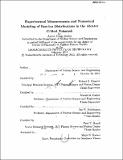| dc.contributor.advisor | Robert S. Granetz and Ronald R. Parker. | en_US |
| dc.contributor.author | Bader, Aaron Craig | en_US |
| dc.contributor.other | Massachusetts Institute of Technology. Dept. of Nuclear Science and Engineering. | en_US |
| dc.date.accessioned | 2013-02-14T15:16:41Z | |
| dc.date.available | 2013-02-14T15:16:41Z | |
| dc.date.copyright | 2012 | en_US |
| dc.date.issued | 2012 | en_US |
| dc.identifier.uri | http://hdl.handle.net/1721.1/76912 | |
| dc.description | Thesis (Ph. D. in Applied Plasma Physics)--Massachusetts Institute of Technology, Dept. of Nuclear Science and Engineering, 2012. | en_US |
| dc.description | Cataloged from PDF version of thesis. | en_US |
| dc.description | Includes bibliographical references (p. 213-220). | en_US |
| dc.description.abstract | In this thesis we discuss measurements and modeling of minority heated fast-ion distributions in the Ion Cyclotron Range of Frequencies (ICRF) on the Alcator C-Mod tokamak. Analysis of fast-ions >100Te is important for both ITER and a future fusion reactor as both will have a significant population of 3.5 MeV alpha particles generated in fusion reactions. Fast particles in this energy range can drive unstable modes such as Toroidal Alfvén Eigenmodes (TAEs) and Reversed Shear Alfvén Eigenmodes (RSAEs). Furthermore, energetic ions may display plasma properties that differ from the bulk plasma. It is crucial to benchmark current simulation codes with measurements from highly energetic fast-ions on current devices. This thesis will focus on measurements of the fast-ion distribution made on C-Mod with an upgraded Compact Neutral Particle Analyzer (CNPA). Measurements of the fast-ion distributions will reveal strong dependences of the fast-ion effective temperature on both electron density and plasma current. For further analysis, we use the simulated distributions generated by the coupled full-wave spectral solver AORSA, with the zero orbit-width bounce-averaged Fokker-Planck code CQL3D. A new synthetic diagnostic integrated into CQL3D is used to make direct comparisons with the CNPA. We find that for plasmas that have a steady-state fast-ion distribution (df /dt = 0) the simulation and the experiment have good agreement. However, in simulations where the fast-ion distribution is evolving in time (df/dt =/ 0) we find a discrepancy between the simulation and the experimental results. The simulation is seen to evolve much slower than the experiment. Various reasons for the discrepancy are explored, including the possibility of a violation of the quasi-linear theory used in CQL3D. | en_US |
| dc.description.statementofresponsibility | by Aaron Craig Bader. | en_US |
| dc.format.extent | 220 p. | en_US |
| dc.language.iso | eng | en_US |
| dc.publisher | Massachusetts Institute of Technology | en_US |
| dc.rights | M.I.T. theses are protected by
copyright. They may be viewed from this source for any purpose, but
reproduction or distribution in any format is prohibited without written
permission. See provided URL for inquiries about permission. | en_US |
| dc.rights.uri | http://dspace.mit.edu/handle/1721.1/7582 | en_US |
| dc.subject | Nuclear Science and Engineering. | en_US |
| dc.title | Experimental measurements and numerical modeling of fast-ion distributions in the Alcator C-Mod Tokamak | en_US |
| dc.type | Thesis | en_US |
| dc.description.degree | Ph.D.in Applied Plasma Physics | en_US |
| dc.contributor.department | Massachusetts Institute of Technology. Department of Nuclear Science and Engineering | |
| dc.identifier.oclc | 824157395 | en_US |
